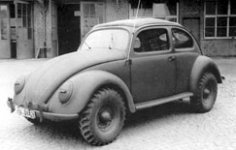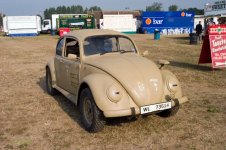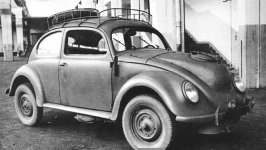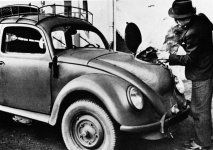From Wiki. Initially designated the Porsche Type 60 by Ferdinand Porsche, the design team included Erwin Komenda and Karl Rabe. In October 1935 the first two Type 60 prototypes, known as the V1 and V2 (V for Versuchswagen, or "test car"), were ready.[14] In 1936, testing of three further V3 prototypes,[14] built in Porsche's Stuttgart shop,[15] began. A batch of thirty W30 development models, produced for Porsche by Daimler-Benz,[14][16] underwent 1,800,000 mi (2,900,000 km)[16] of further testing in 1937. All cars already had the distinctive round shape and the air-cooled, rear-mounted engine. Included in this batch was a rollback soft top called the Cabrio Limousine.[17] A further batch of 44 VW38 pre-production cars produced in 1938 introduced split rear windows; both the split window and the dash were retained on production Type 1s until 1952.[16] The VW38 cars were followed by another batch of 50 VW39 cars, completed in July 1939.[18]
The car was designed to be as simple as possible mechanically, so that there was less to go wrong; the aircooled 25 hp (19 kW) 995 cc (60.7 cu in)[19] motors proved especially effective in actions of the German Afrika Korps in Africa's desert heat. This was due to the built-in oil cooler and the superior performance of the flat-4 engine configuration. The suspension design used compact torsion bars instead of coil or leaf springs. The Beetle is nearly airtight and will float for a few minutes on water.[20]
The Volkswagen was officially named the KdF-Wagen by Hitler when the project was officially announced in 1938.[21] The name refers to Kraft durch Freude ('Strength Through Joy'), the official leisure organization of the Third Reich. The model village of Stadt des KdF-Wagens was created near Fallersleben in Lower Saxony in 1938 for the benefit of the workers at the newly-built factory. After World War II, it was known as the Volkswagen Type 1, but became more commonly known as the Beetle. Michael










